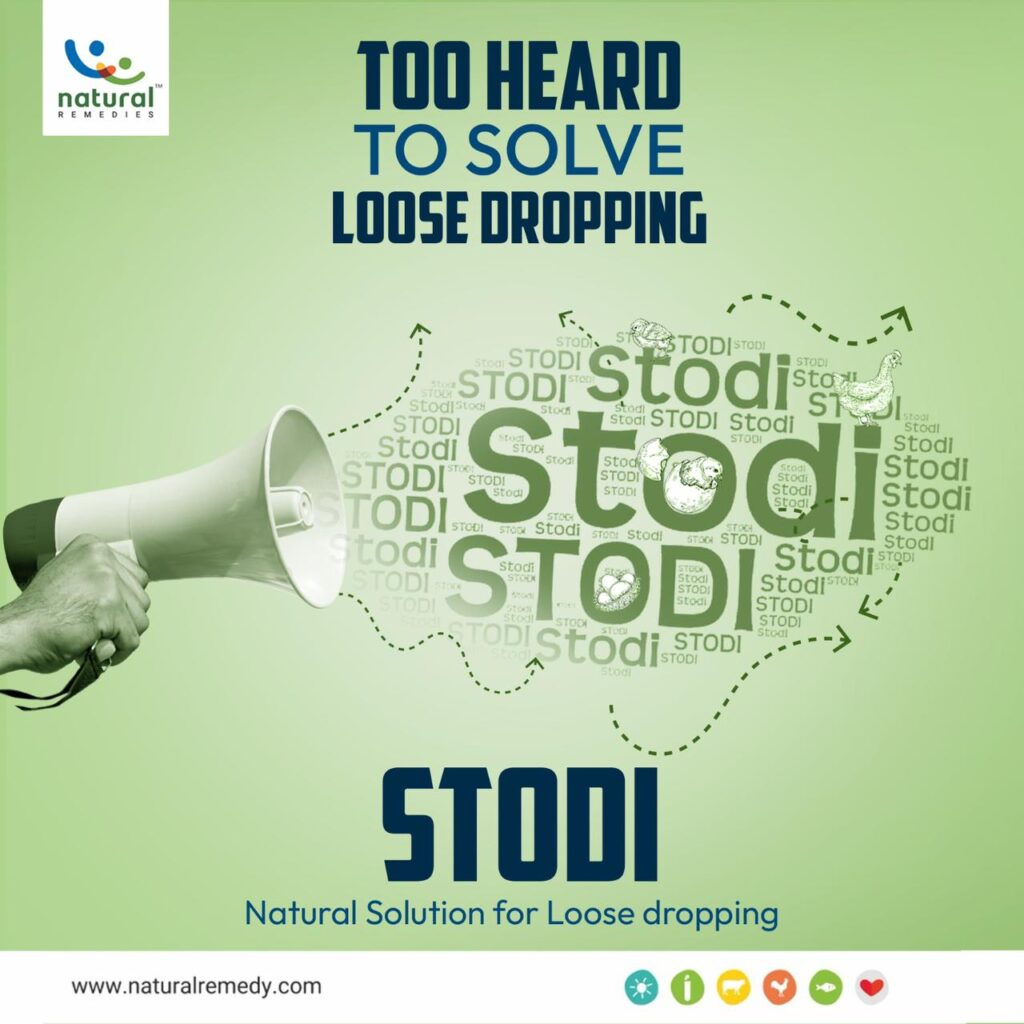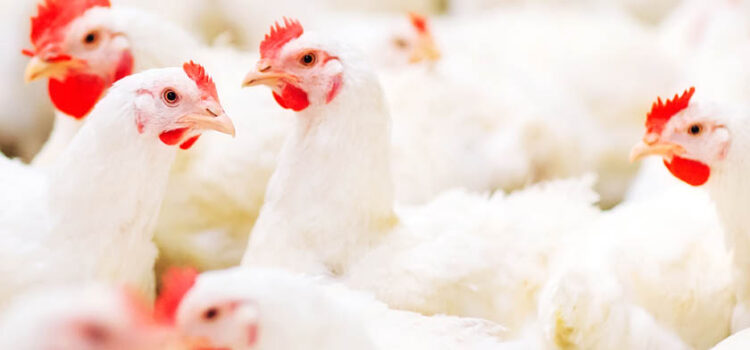The poultry industry in India has witnessed significant growth over the years, making it one of the largest contributors to the country’s agriculture sector. Poultry farming has become a source of livelihood for many, and it plays a crucial role in providing a steady supply of eggs and meat to the growing population. However, as the poultry sector continues to expand, it faces a pressing issue that threatens the health and well-being of the birds and the livelihoods of poultry farmers. Loose dropping is one of the common diseases affecting poultry health and production. Loose droppings involve the excretion of loose, unformed faeces by the birds, which is often accompanied by increased water content and a lack of consistency.
 One of the most challenging aspects of addressing loose droppings in poultry is the non-specific nature of the causes. Unlike specific diseases or pathogens that can be easily identified and targeted, loose droppings may be triggered by a range of factors, making diagnosis and treatment complex. The non-specific causes of loose dropping involve management, environment, metabolism, and nutrition.
One of the most challenging aspects of addressing loose droppings in poultry is the non-specific nature of the causes. Unlike specific diseases or pathogens that can be easily identified and targeted, loose droppings may be triggered by a range of factors, making diagnosis and treatment complex. The non-specific causes of loose dropping involve management, environment, metabolism, and nutrition.
Environment and temperature one of the pre-disposing factors responsible for the occurrence of loose dropping in poultry. When birds are exposed to high temperatures inside the shed, it can cause stress in them and cause them to drink more and eat less to regulate their body temperature. Furthermore, it has been demonstrated that heat stress damages intestinal integrity and leads to a leaky and inflammatory gut. Loose dropping will result from less intestinal water absorption due to compromised gut integrity. Whereas in low temperatures and high humidity, poultry tends to eat more and reduce water intake. A reduction in water intake can be an indication of dysbacteriosis. The ventilation systems in a chicken house are intimately related to the ammonia content there. Poor ventilation causes poultry houses to have excessive levels of ammonia, which is a common problem during winter. In the poultry house, an ammonia level of more than 25 ppm has a negative impact on the health and productivity of the birds. High levels of ammonia can interfere with normal organ function, hinder energy metabolism, promote cell apoptosis, and harm the mitochondria in the mucosa of the digestive system.
Nutrition plays a pivotal role in the occurrence of loose dropping in poultry. Due to frequent fluctuations in feed prices, poultry farmers are looking for alternative ways to balance the ration. A variety of antinutritional elements found in alternative feed sources, whether they are protein- or energy-based, impact gut integrity and feed digestion, resulting in loose dropping. Numerous factors, such as a diet rich in non-starch polysaccharides, Distiller’s dried grains (DDGS), soyabean meal (SBM) quality, low-quality fat, and high salt and minerals, etc, contribute to loose dropping in poultry.
SBM contains several antinutritional elements that could alter intestinal homeostasis and reduce poultry’s ability to utilize nutrients. The main anti-nutritional factors in SBM, are trypsin inhibitors. According to reports, the quantity of trypsin inhibitors in the diet is directly connected with outbreaks of rapid feed passage in broilers. High trypsin inhibitor levels in soybean meal are an indicator that the processing conditions were not ideal for reducing trypsin inhibitor content in raw soybeans from about 40 mg/g to a concentration of around 2 mg/g in soybean meal.
The economic impact of loose droppings on poultry farms is considerable. Poultry farmers face financial difficulties because of decreased growth rates, increased mortality, and higher feed and medicine expenditures. Considering these challenges, poultry farmers must implement strategies to mitigate the effects of loose droppings. In order to lessen stress on the birds, this requires maintaining optimal environmental conditions. To reduce the likelihood of loose droppings, it’s essential to maintain high-quality, balanced food and closely monitor the water supply. Furthermore, various phytogenic feed additives have also been shown to lessen the possibilities of loose dropping in poultry. The active ingredients found in natural preparations are classified as plant secondary metabolites (PSM) and can have a wide range of biological effects on an animal’s body. Depending on their concentration and combination, they may have antibacterial, anti-inflammatory, as well as antioxidant properties.
 STODI a pure phytogenic formulation, supports in prevention of non-specific loose droppings in poultry. STODI is composed of Andrographolide, punicalagin, polyphenols, and ellagitannins which work synergistically to prevent loose dropping in poultry. In a study conducted on rats, it was found that castor oil-induced diarrhea was significantly reduced. Also, the intestinal transit was inhibited by up to 33% and the weight of secretory contents induced by castor oil was significantly reduced by polyherbal formulation, approximately 29% in the enterpooling assay. In another study conducted in Ross 308 broiler chicks, were treated with magnesium chloride in the negative control group whereas the STODI group contained magnesium chloride along with STODI. It was found that supplementation of STODI was effective in modulating the caecal microbial population in a manner conducive to gut health and performance of broilers, as revealed by the increase in abundance of favorable microflora. STODI has also proven that a wet litter broiler model was developed through excessive feeding of MgCl2, which caused the performance parameters to worsen, and the emergence of problems associated with the wet litter. Supplementation with STODI ameliorated these problems and, therefore, it can be used for the management of wet litter in poultry by its properties of augmenting gut integrity, anti-inflammatory effects on the intestinal lumen, check hyper-secretion, normalizing gut peristalsis, enhancing gut immunity and improves microbiome.
STODI a pure phytogenic formulation, supports in prevention of non-specific loose droppings in poultry. STODI is composed of Andrographolide, punicalagin, polyphenols, and ellagitannins which work synergistically to prevent loose dropping in poultry. In a study conducted on rats, it was found that castor oil-induced diarrhea was significantly reduced. Also, the intestinal transit was inhibited by up to 33% and the weight of secretory contents induced by castor oil was significantly reduced by polyherbal formulation, approximately 29% in the enterpooling assay. In another study conducted in Ross 308 broiler chicks, were treated with magnesium chloride in the negative control group whereas the STODI group contained magnesium chloride along with STODI. It was found that supplementation of STODI was effective in modulating the caecal microbial population in a manner conducive to gut health and performance of broilers, as revealed by the increase in abundance of favorable microflora. STODI has also proven that a wet litter broiler model was developed through excessive feeding of MgCl2, which caused the performance parameters to worsen, and the emergence of problems associated with the wet litter. Supplementation with STODI ameliorated these problems and, therefore, it can be used for the management of wet litter in poultry by its properties of augmenting gut integrity, anti-inflammatory effects on the intestinal lumen, check hyper-secretion, normalizing gut peristalsis, enhancing gut immunity and improves microbiome.
In conclusion, the poultry industry in India has seen remarkable growth, playing a pivotal role in meeting the country’s increasing demand for poultry products. However, the emergence of loose droppings in poultry flocks is a complex challenge that threatens the health of birds and the livelihoods of poultry farmers. The economic impact of loose droppings on poultry farms is substantial, causing reduced growth rates, higher mortality rates, and increased costs associated with feed and medication. To mitigate these challenges, poultry farmers must adopt a multifaceted approach, the use of phytogenic feed additives like STODI has shown promise in supporting the prevention of non-specific loose droppings in poultry.
References:
-
Dunlop, M.W., Moss, A.F., Groves, P.J., Wilkinson, S.J., Stuetz, R.M. and Selle, P.H., 2016. The multidimensional causal factors of ‘wet litter’in chicken-meat production. Science of the Total Environment, 562, pp.766-776.
-
Hermans, P.G., Fradkin, D., Muchnik, I.B. and Morgan, K.L., 2006. Prevalence of wet litter and the associated risk factors in broiler flocks in the United Kingdom. Veterinary Record, 158(18), pp.615-622.
-
https://www.biomin.net/science-hub/5-tips-to-successfully-manage-poultry-house-ammonia-levels/#:~:text=Optimize%20the%20poultry%20stocking%20density,temperature%20of%20the%20poultry%20house.
-
https://www.poultryproducer.com/wet-droppings-or-diarrhea/#:~:text=Excessive%20water%20intake%20has%20a,to%20regulate%20their%20body%20temperature.
-
Makwana, R.B., Savsani, H.H., Chavda, M.R., Odedra, M.D., Garg, D.D., Ribadiya, N.K., Karangiya, V.K., Vaghamashi, D.G., Chavda, J.A. and Belim, S.Y., 2022. Constraints and amelioration of non-starch polysaccharides (NSP) in broiler diets: A review.
-
Marimuthu, S., Balasubramanian, B., Selvam, R. and D’Souza, P., 2019. Evaluation of a polyherbal formulation for the management of wet litter in broiler chickens: Implications on performance parameters, cecal moisture level, and footpad lesions. Journal of Advanced Veterinary and Animal Research, 6(4), p.536.
-
Marimuthu, S.K., Balasubramanian, B., Selvam, R. and D’Souza, P., 2019. Modulation of chicken cecal microbiota by a phytogenic feed additive, STODI®: a metagenomic analysis. Pharmacognosy Research, 11(3).
-
Murugan, S., Purusothaman, D., Richard, E.J., Chalichem, N.S.S., Bethapudi, B., Chandrasekaran, P.R., Velusami, C.C., D’Souza, P. and Mundkinajeddu, D., 2020. Anti-diarrhoeal activity of a polyherbal formulation in rats and elucidation of its cellular mechanisms. Avicenna journal of phytomedicine, 10(4), p.417.
-
Sheikh, I.U., Nissa, S.S., Zaffer, B., Bulbul, K.H., Akand, A.H., Ahmed, H.A., Hasin, D., Hussain, I. and Hussain, S.A., 2018. Ammonia production in the poultry houses and its harmful effects. J. Vet. Sci. Anim. Husb, 3(4), pp.30-33.
Similar article: How Phytogenics Helps During Toxicity Of Liver?






